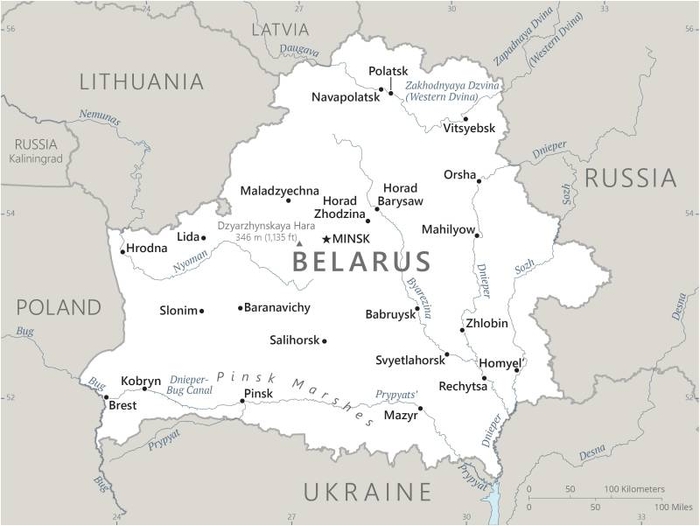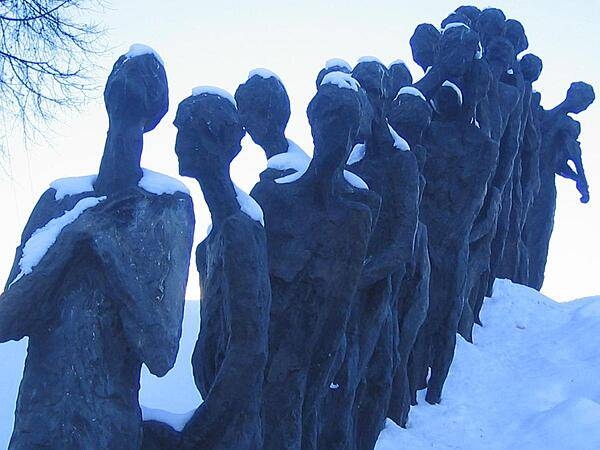57 Belarus

Red horizontal band (top) and green horizontal band one-half the width of the red band. A white vertical stripe on the hoist side bears Belarusian national ornamentation in red. The red band color recalls past struggles from oppression, the green band represents hope and the many forests of the country.
Flag courtesy of the CIA World Factbook

Map courtesy of the CIA World Factbook

A view of the Yama (Death Pit) Holocaust Memorial in Minsk. The figures are part of a group descending into the pit to be executed.
Photo courtesy of the CIA World Factbook
Government
According to Britannica, a new constitution that characterized the republic as a “democratic, social state” and guaranteed a broad range of rights and freedoms entered into force in Belarus in March 1994. It was based on the separation of legislative, executive, and judicial powers. Under the 1994 constitution, deputies were elected by universal adult suffrage for five-year terms to the government’s highest legislative body, the Supreme Soviet, which confirmed the budget, called for national elections and referenda, and was responsible for domestic, foreign, and military policy. Following the passage of a referendum (whose legitimacy was questioned by many Belarusians and by much of the international community) in November 1996, however, the constitution was revised to greatly expand the powers of the president.
Thus, Pres. Alexander Lukashenko, who had been elected to the office in 1994, gained the right to prolong his term in office and to rule by decree. The amended constitution also greatly diminished the powers of a reconstituted parliament, the bicameral National Assembly. Pro-Lukashenko candidates predominated in subsequent legislative elections, which were deemed irregular or undemocratic by international observers.
Under the terms of the constitution, the president, who is the head of state, is popularly elected for a five-year term. The president appoints the prime minister, who nominally is the head of government but, in effect, is subordinate to the president. The National Assembly consists of the Council of the Republic and the House of Representatives. Members of the Council serve four-year terms; most are elected by regional councils, but a small number are appointed by the president. Members of the House are popularly elected to serve four-year terms.
There are three tiers of local government. The largest consists of six voblastsi (provinces) and one municipality (horad), Minsk. The provinces in turn are divided into rayony (sectors) and cities, with some larger cities further divided into rayony. Towns, villages, and settlements constitute the final tier.
The judicial system comprises the Supreme Court and its lower courts, the Supreme Economic Court and its lower courts, and the Constitutional Court, which has final ruling on the republic’s basic law. The Constitutional Court is made up of 12 judges, who serve 11-year terms. Half the judges are appointed by the president, and half are elected by the Council of the Republic.
Ministry of Transport and Communications
The Aviation Division of the Ministry of Transport and Communications of the Republic of Belarus with the rights of a legal entity (hereinafter referred to as the Division) is a structural unit of the central office of the Ministry of Transport and Communications of the Republic of Belarus (hereinafter referred to as the Ministry of Transport), which carries out special (executive, control, regulatory and other) functions in the field of civil aviation related to the competence of the Ministry of Transport. The main tasks of the Division are:
– meeting the needs of the economy and the population in the air transportation of passengers, baggage, cargo and mail;
– pursuing economic and scientific-technical policy in the field of civil aviation;
– implementation of state control over activities in the field of civil aviation in accordance with the law.
Airspace
SkyVector – Google Maps – ADS-B Exchange
ICAO countries publish an Aeronautical Information Publication (AIP). This document is divided into three parts: General (GEN), En Route (ENR) and Aerodromes (AD). ENR 1.4 details the types of airspace classes they chose to adopt from classes A through G.
Belarus ANS
Belarus ANS – BELAERONAVIGATSIA REPUBLICAN UNITARY AIR NAVIGATION SERVICES ENTERPRISE – BELAERONAVIGATSIA Republican Unitary Air Navigation Services Enterprise was founded in 1996 in compliance with Decree of the President of the Republic of Belarus No. 126 of 4 April 1995. BELAERONAVIGATSIA State-Owned Enterprise is the provider of air navigation services in the Republic of Belarus.
Drone Regulations
Air Code of the Republic of Belarus – specifically Chapter 4 – UAS
Advanced Air Mobility (AAM) Regulations & Policies
None found by the author.
However, should you, the reader, happen to stumble across something to the contrary, please email the author at FISHE5CA@erau.edu and you may be mentioned in the ACKNOWLEDGEMENTS section of this book by way of thanks for contributing to this free eBook!
Advanced Air Mobility (AAM) News
None found by the author.
However, should you, the reader, happen to stumble across something to the contrary, please email the author at FISHE5CA@erau.edu and you may be mentioned in the ACKNOWLEDGEMENTS section of this book by way of thanks for contributing to this free eBook!
Short Essay Questions
Scenario-Based Question
You have been hired by a Drone Startup Company. Your boss has immediately assigned this job to you.
They need you to prepare a one-page memo detailing the legalities of using a drone over Minsk, pictured above.
They need you to mention any national laws and local ordinances.
They specifically want to know what airspace (insert pictures) you will be operating in and whether or not you need an airspace authorization.
Does it matter whether or not you are a citizen of the country?
Lastly, there is a bonus for you if, as you scroll through this chapter, you find any typos or broken links!
Short Essay Questions
- What are the drone categories?
- How is registration addressed?
- How is remote ID addressed?
- What are the model aircraft rules?
- What are the commercial drone rules?
- Are there waivers or exemptions to the rules? If so, for what?
- Would you share a link to an interactive airspace map?
- How is BVLOS addressed?
- How can you fly drones at night?
- How can you fly drones over people?
- Where do you find drone NOTAMs?
- What are the rules for drone maintenance?
- What are the rules for an SMS program?
- What are some unique rules not mentioned above?
- What are the C-UAS rules?
- What are the AAM rules?

